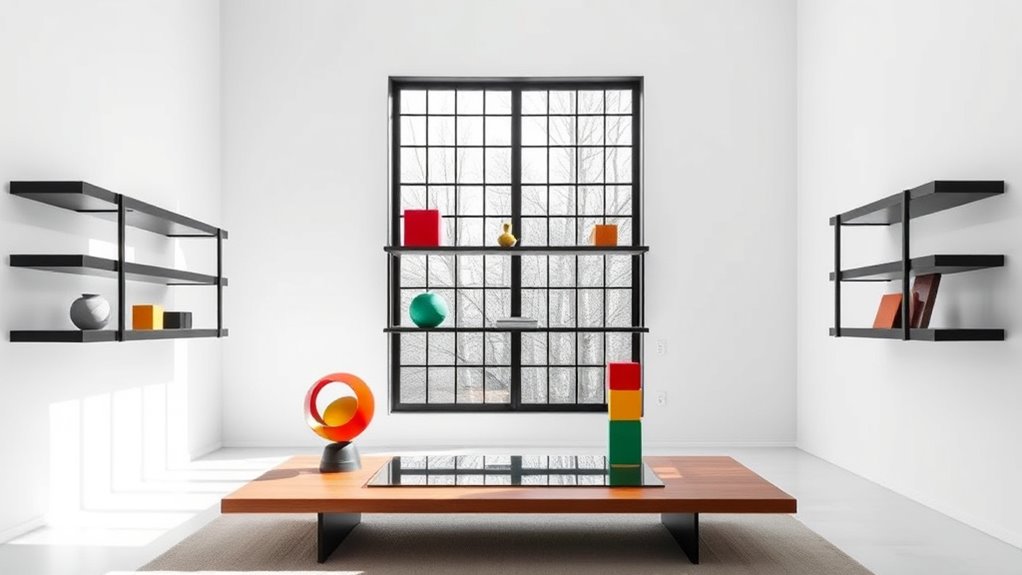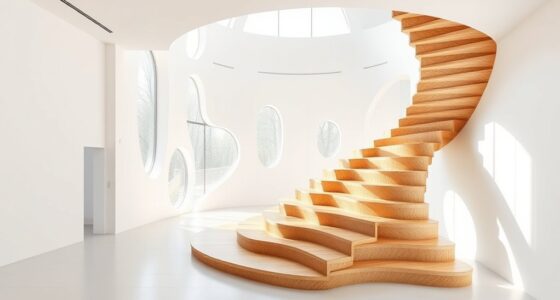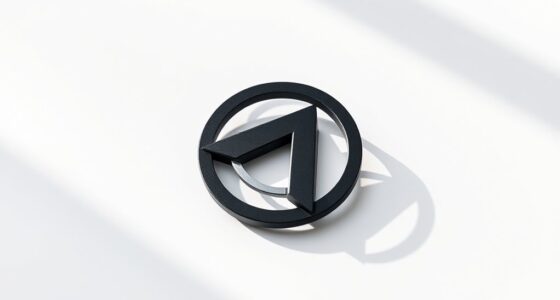The Bauhaus emphasizes geometry as the foundation of modern design, focusing on simple shapes like circles, squares, and triangles to create functional and minimalist forms. It guides you to see design as a balance of aesthetics and purpose, with each element serving a clear role. By applying geometric principles, Bauhaus achieves harmony, clarity, and universal appeal. Explore further to discover how these ideas continue to influence contemporary design with timeless simplicity.
Key Takeaways
- Bauhaus emphasizes the use of basic geometric shapes to create functional and minimalist designs.
- Geometry guides all design decisions, ensuring harmony, balance, and simplicity in modern architecture and products.
- The movement advocates for form following function, with geometric abstraction enhancing usability and clarity.
- Bauhaus integrates geometry into space, form, and composition for cohesive and timeless aesthetics.
- Its principles have profoundly influenced modern design, promoting efficiency, clarity, and universal accessibility.

The Bauhaus movement revolutionized design by emphasizing the fundamental role of geometry in creating functional and aesthetically compelling forms. You quickly realize that at its core, Bauhaus champions functional minimalism, where every element serves a purpose, and unnecessary details are stripped away. This approach isn’t just about simplicity; it’s about clarity of form driven by geometric abstraction. You see how this focus on fundamental shapes—circles, squares, triangles—guides the entire design process, ensuring that each piece is both visually balanced and practical.
As you explore Bauhaus work, it becomes clear that geometry isn’t just decorative; it’s the foundation of all design decisions. You notice how architects and designers use geometric principles to construct furniture, buildings, and even typography that embody efficiency and harmony. This isn’t about ornate embellishments but about understanding how basic shapes interact and relate to each other. The use of geometric abstraction allows you to see complex forms broken down into their simplest, most recognizable components. This clarity makes the designs universally accessible and timeless.
You observe that the Bauhaus’s embrace of geometric abstraction naturally leads to a focus on function. It’s not enough for a form to look good; it must also work effectively. You notice how the geometric forms often follow the ergonomic or structural needs of the object. For example, a chair designed with this philosophy uses clear, geometric shapes to support comfort while maintaining a sleek, minimalist profile. The emphasis on functional minimalism means every line and curve is deliberate, avoiding superfluous decoration. This clarity of purpose makes the design intuitive and user-friendly.
Furthermore, the Bauhaus’s integration of geometry influences how you perceive space and form. You see how geometric principles can unify disparate elements, creating cohesive compositions that feel both dynamic and balanced. When you look at Bauhaus architecture or product design, you recognize the harmony achieved through precise geometric proportions. This understanding helps you appreciate how geometric abstraction isn’t just an aesthetic choice but a practical tool for solving design problems.
You realize that the Bauhaus’s focus on basic geometric shapes has had a lasting impact on modern design, inspiring countless contemporary movements that prioritize simplicity and function. In essence, your journey through Bauhaus design reveals how geometry forms the backbone of modern aesthetics. It’s a language that communicates efficiency, clarity, and beauty simultaneously. You grasp that by prioritizing geometric abstraction and embracing functional minimalism, Bauhaus created a legacy of design that’s still relevant today—where form and function are inseparable, and simplicity is the ultimate sophistication.
Frequently Asked Questions
How Did Bauhaus Principles Influence Contemporary Architectural Practices?
You see Bauhaus principles influence contemporary architecture through a focus on functional design and simplicity. You incorporate color theory to create visually appealing spaces and prioritize material innovation to develop sustainable, versatile structures. These principles encourage you to blend form and function seamlessly, emphasizing clean lines and practical aesthetics. As a result, modern architecture often reflects Bauhaus ideals, fostering innovative, user-centered environments that are both beautiful and efficient.
What Are the Key Geometric Patterns Used in Bauhaus Design?
Think of Bauhaus design as a well-orchestrated symphony, where geometric patterns set the rhythm. You’ll notice symmetrical patterns that provide balance and harmony, like a mirror reflecting perfect order. Tessellation techniques create intricate, repeating shapes that fit together seamlessly, forming mesmerizing surfaces. These key geometric patterns serve as the backbone of Bauhaus, guiding your eye and establishing clarity, simplicity, and unity in modern architecture and design.
Who Were the Leading Bauhaus Designers Specializing in Geometric Forms?
You’ll find that Bauhaus masters like Wassily Kandinsky, Paul Klee, and László Moholy-Nagy specialized in geometric abstraction, using bold shapes and lines to create innovative designs. They emphasized geometric forms as fundamental to modern aesthetics, influencing countless artists and designers. Their work showcases a mastery of geometric patterns, making them key figures in the Bauhaus movement and in shaping modern design’s focus on form and function.
How Does Bauhaus Geometry Compare to Other Modernist Movements?
Think of Bauhaus geometry as a precise symphony, blending form and function seamlessly. Compared to other modernist movements, it emphasizes clean lines, simplicity, and functional design, making it stand out. The differences lie in its focus on geometric evolution—shaping everyday objects with sharp, logical forms. This approach creates a visual language that’s both innovative and timeless, setting the stage for modern design’s future.
What Tools Did Bauhaus Artists Use to Create Geometric Designs?
You use simple tools like rulers, compasses, and straightedges to create precise geometric designs. Bauhaus artists also explore color theory to enhance their compositions, blending bold hues with geometric shapes. Material experimentation plays a key role, as you test different mediums like glass, metal, and textiles to bring your designs to life. These tools and techniques help you craft modern, innovative works rooted in geometric clarity and experimental creativity.
Conclusion
You now see how the Bauhaus revolutionized modern design through its mastery of geometry, emphasizing simplicity and functionality. notably, over 60% of Bauhaus designs still influence contemporary architecture today. By embracing geometric principles, you can create timeless, efficient spaces that blend art and practicality seamlessly. So, next time you admire sleek buildings or minimalist furniture, remember that it all stems from the Bauhaus’s geometric foundation, shaping the world around you in profound ways.









